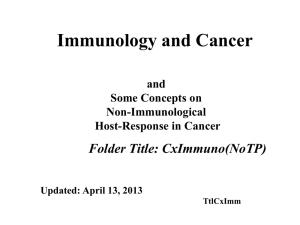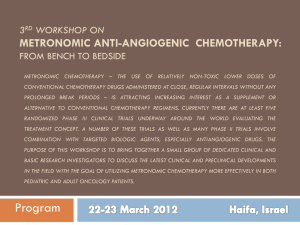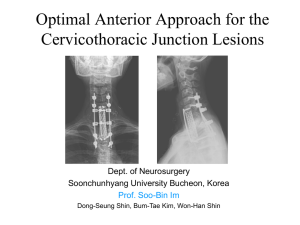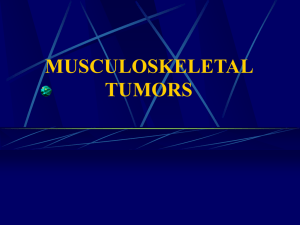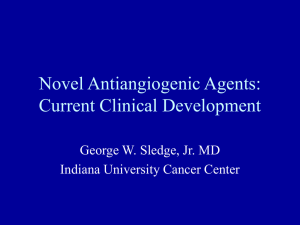Chemotherapy
advertisement
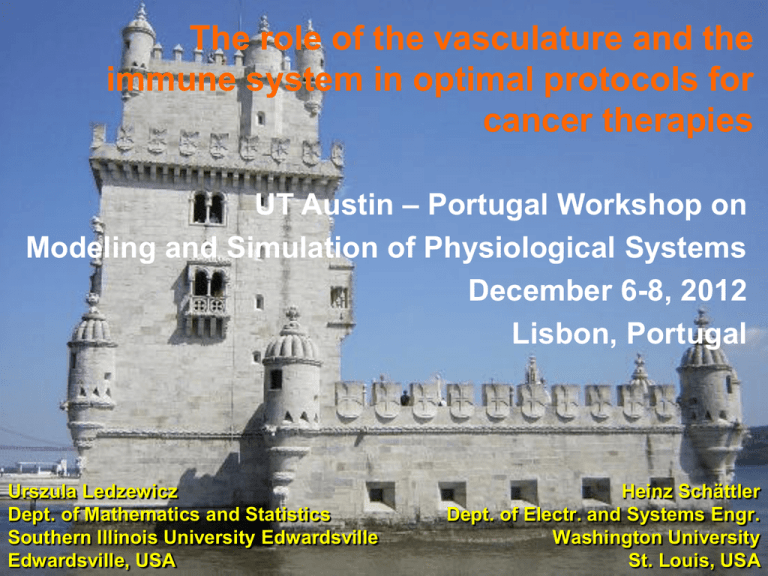
The role of the vasculature and the immune system in optimal protocols for cancer therapies UT Austin – Portugal Workshop on Modeling and Simulation of Physiological Systems December 6-8, 2012 Lisbon, Portugal Urszula Ledzewicz Dept. of Mathematics and Statistics Southern Illinois University Edwardsville Edwardsville, USA Heinz Schättler Dept. of Electr. and Systems Engr. Washington University St. Louis, USA Forthcoming Books • Heinz Schättler and Urszula Ledzewicz, Geometric Optimal Control – Theory, Methods, Examples Springer Verlag, July 2012 • Urszula Ledzewicz and Heinz Schättler, Geometric Optimal Control Applied to Biomedical Models Springer Verlag, 2013 • Mathematical Methods and Models in Biomedicine Urszula Ledzewicz, Heinz Schättler, Avner Friedman and Eugene Kashdan, Eds. Springer Verlag, November 2012 Main Collaborators and Contacts Alberto d’Onofrio European Institute for Oncology, Milano, Italy Helmut Maurer Rheinisch Westfälische WilhelmsUniversität Münster, Münster, Germany Andrzej Swierniak Silesian University of Technology, Gliwice, Poland Avner Friedman MBI, The Ohio State University, Columbus, Oh External Grant Support Research supported by collaborative research NSF grants DMS 0405827/0405848 DMS 0707404/0707410 DMS 1008209/1008221 Components of Optimal Control Problems min or max objective dynamics response (model) disturbance control (unmodelled dynamics) Outline – An Optimal Control Approach to … • model for drug resistance under chemotherapy • a model for antiangiogenic treatment • a model for combination of antiangiogenic treatment with chemotherapy • a model for tumor-immune interactions under chemotherapy and immune boost • conclusion and future work: model for tumor microenvironment and metronomic chemotherapy Optimal Drug Treatment Protocols Main Questions QUESTION 1: HOW MUCH? QUESTION 2: HOW OFTEN? (dosage) (timing) QUESTION 3: IN WHAT ORDER? (sequencing) Heterogeneity and Tumor Microenvironment Tumors are same size but contain different composition of chemo-resistant and –sensitive cells. Chemo-sensitive tumor cell Fibroblast Tumor stimulating myeloid cell Chemo-resistant tumor cell Endothelia Surveillance T-cell Model for Drug Resistance under Chemotherapy aS(t), cR(t) outflow of sensitive/resistance cells u – cytotoxic drug dose rate, 0≤u≤1 Mutates division p(1-u)aS S R (1-u)aS aS (2-p)(1-u)aS uaS - killed remains sensitive one-gene forward gene amplification hypothesis, Harnevo and Agur • cR(t) – outflow of resistant cells division rcR Mutates back R cR (2-r)cR S remains resistant • dynamics Mathematical Model: Objective minimize the number of cancer cells left without causing too much harm to the healthy cells: let N=(S,R)T Weighted average of number of cancer cells at end of therapy Weighted average of cancer cells during therapy Toxicity of the drug (side effects on healthy cells) From Maximum Principle: Candidates for Optimal Protocols • bang-bang controls • singular controls umax T treatment protocols of maximum dose therapy periods with rest periods in between MTD T continuous infusions of varying lower doses BOD Results [LSch, DCDS, 2006] From the Legendre-Clebsch condition • If pS>(2-p)R, then bang-bang controls (MTD) are optimal • If pS<(2-p)R, then singular controls (lower doses) become optimal • Passing a certain threshold, time varying lower doses are recommended “Markov Chain” Models Tumor Anti-angiogenesis Tumor Anti-Angiogenesis avascular growth angiogenesis metastasis http://www.gene.com/gene/research/focusareas/oncology/angiogenesis.html Tumor Anti-angiogenesis Judah Folkman, 1972 • suppress tumor growth by preventing the recruitment of new blood vessels that supply the tumor with nutrients (indirect approach) • done by inhibiting the growth of the endothelial cells that form the lining of the new blood vessels therapy “resistant to resistance” • anti-angiogenic agents are biological drugs (enzyme inhibitors like endostatin) – very expensive and with side effects Model [Hahnfeldt,Panigrahy,Folkman, Hlatky],Cancer Research, 1999 p – tumor volume q – carrying capacity u – anti-angiogenic dose rate p,q – volumes in mm3 - tumor growth parameter - endogenous stimulation (birth) - endogenous inhibition (death) - anti-angiogenic inhibition parameter - natural death Lewis lung carcinoma implanted in mice Optimal Control Problem For a free terminal time over all functions subject to the dynamics minimize that satisfy Synthesis of Optimal Controls [LSch, SICON, 2007] 18000 p u=a 16000 u=0 14000 tumor cells 12000 10000 8000 an optimal trajectory end of “therapy” begin of therapy 6000 4000 final point – minimum of p 2000 0 0 2000 4000 6000 8000 10000 endothelial cells 12000 typical synthesis: 14000 16000 q 18000 umax→s→0 An Optimal Controlled Trajectory for [Hahnfeldt et al.] Initial condition: p0 = 12,000 q0 = 15,000, umax=75 u 70 maximum dose rate 60 optimal control u 50 40 q0 30 lower dose rate - singular 20 averaged optimal dose no dose 10 0 0 1 2 3 4 5 6 7 time robust with respect to q0 Anti-Angiogenic Treatment with Chemotherapy A Model for a Combination Therapy [d’OLMSch, Mathematical Biosciences, 2009] Minimize subject to angiogenic inhibitors cytotoxic agent or other killing term with d’Onofrio and H. Maurer Questions: Dosage and Sequencing • Chemotherapy needs the vasculature to deliver the drugs • Anti-angiogenic therapy destroys this vasculature • In what dosages? • Which should come first ? Optimal Protocols tumor volume, p 13000 12000 optimal angiogenic monotherapy 11000 10000 9000 8000 7000 4000 6000 8000 10000 12000 14000 carrying capacity of the vasculature, q 16000 Controls and Trajectory [for dynamics from Hahnfeldt et al.] dosage angio 70 60 50 13000 40 tumor volume, p 30 20 10 0 0 1 2 3 4 5 6 7 time (in days) 12000 11000 10000 dosage chemo 9000 8000 1 0.8 7000 0.6 4000 6000 8000 10000 12000 14000 carrying capacity of the vasculature, q 0.4 0.2 0 -0.2 0 1 2 3 4 5 6 time (in days) 7 16000 Medical Connection Rakesh Jain, Steele Lab, Harvard Medical School, “there exists a therapeutic window when changes in the tumor in response to antiangiogenic treatment may allow chemotherapy to be particularly effective” Tumor Immune Interactions Mathematical Model for Tumor-Immune Dynamics Stepanova, Biophysics, 1980 Kuznetsov, Makalkin, Taylor and Perelson, Bull. Math. Biology, 1994 de Vladar and Gonzalez, J. Theo. Biology, 2004, d’Onofrio, Physica D, 2005 STATE: - primary tumor volume - immunocompetent cell-density (related to various types of T-cells) Dynamical Model - tumor growth parameter - rate at which cancer cells are eliminated through the activity of T-cells - constant rate of influx of T-cells generated by primary organs - natural death of T-cells - calibrate the interactions between immune system and tumor - threshold beyond which immune reaction becomes suppressed by the tumor Phaseportrait for Gompertz Growth • we want to move the state of the system into the region of attraction of the benign equilibrium minimize Formulation of the Objective controls • u(t) – dosage of a cytotoxic agent, chemotherapy • v(t) – dosage of an interleukin type drug, immune boost • side effects of the treatment need to be taken into account • the therapy horizon T needs to be limited minimize ( (b,a)T is the stable eigenvector of the saddle and c, d and s are positive constants) Optimal Control Problem [LNSch,J Math Biol, 2011] For a free terminal time T minimize over all functions and subject to the dynamics Chemotherapy – log-kill hypothesis Immune boost Chemotherapy with Immune Boost • “cost” of immune boost is high and effects are low compared to chemo • trajectory follows the optimal chemo monotherapy and provides final boosts to the immune system and chemo at the end 3 1s01 1 010 2.5 0.8 - chemo 0.6 * * “free pass” 2 - immune boost 1.5 0.4 * 1 0.2 0.5 * * 0 0 2 4 6 8 10 12 0 0 200 400 600 800 Summary and Future Direction: Combining Models Which parts of the tumor microenvironment need to be taken into account? • cancer cells ( heterogeneous, varying sensitivities, …) • vasculature (angiogenic signaling) • tumor immune interactions • healthy cells Wholistic Approach ? • Minimally parameterized metamodel • Multi-input multi-target approaches • Single-input metronomic dosing of chemotherapy Future Direction: Metronomic Chemotherapy How is it administered? • treatment at much lower doses ( between 10% and 80% of the MTD) • over prolonged periods Advantages 1. lower, but continuous cytotoxic effects on tumor cells • lower toxicity (in many cases, none) • lower drug resistance and even resensitization effect 2. antiangiogenic effects 3. boost to the immune system Metronomics Global Health Initiative (MGHI) http://metronomics.newethicalbusiness.org/





